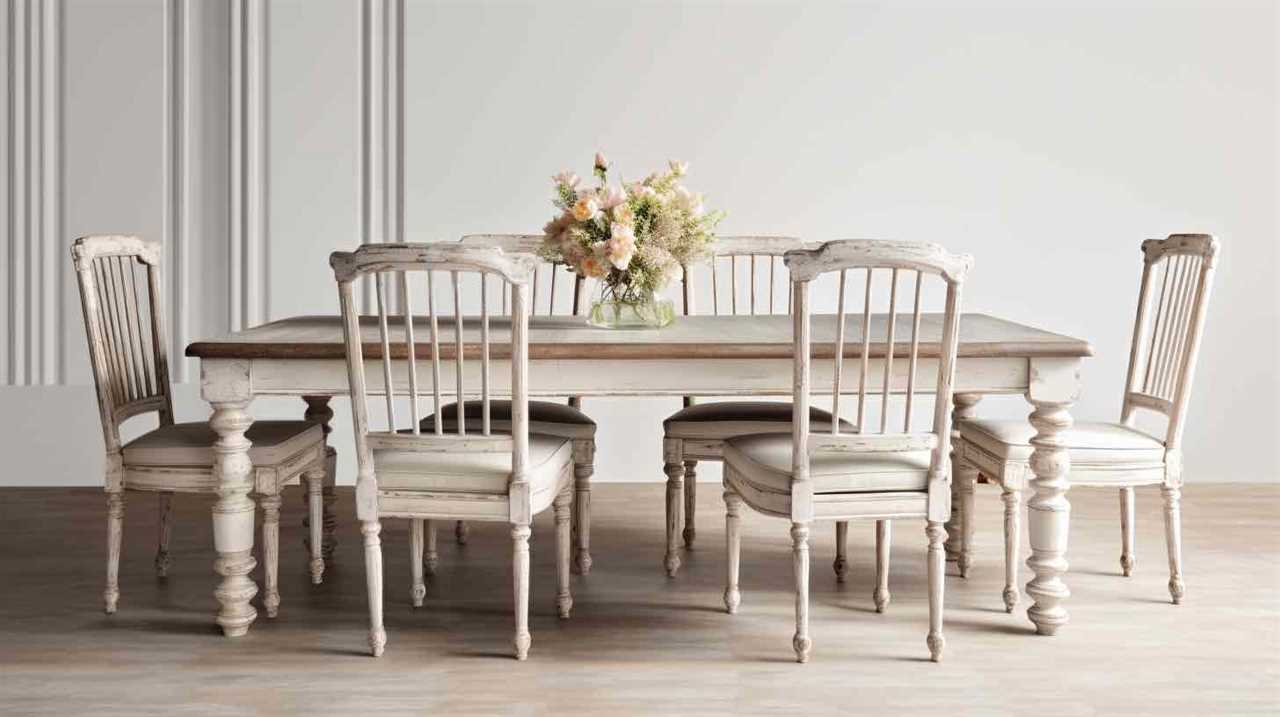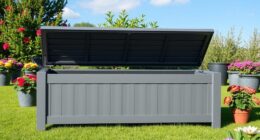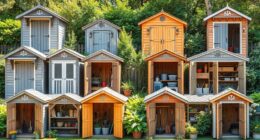To do board-and-batten siding right, focus on quality materials like cedar or engineered wood to guarantee durability and authenticity. Proper installation is key—make sure wide boards fit snugly and battens cover the joints to seal gaps against water and weather. Regular maintenance, such as sealing or staining, keeps it looking great and performing well over time. Keep these details in mind, and you’ll discover how to achieve a timeless, weather-resistant finish that lasts.
Key Takeaways
- Use high-quality materials like cedar or engineered wood for durability and authentic appearance.
- Ensure precise installation of wide boards and battens to achieve a seamless, textured look.
- Seal and stain regularly to preserve natural textures, prevent water infiltration, and extend lifespan.
- Cover joints with battens effectively to enhance weather resistance and prevent gaps.
- Incorporate historic craftsmanship details for an authentic, vintage aesthetic aligned with traditional design.

Board-and-batten siding is a classic exterior cladding style that combines wide boards with narrow strips called battens to create a distinctive, textured look. When you choose this siding, you’re embracing a design that has stood the test of time, often associated with historic authenticity. Whether you’re restoring an old farmhouse or aiming for a timeless appearance on a new build, board-and-batten instantly evokes a sense of tradition and craftsmanship. This style isn’t just about aesthetics; it also offers practical benefits that make it a popular choice among homeowners seeking durability and longevity.
One of the key advantages of board-and-batten siding is its excellent weather resistance. The wide boards, typically made from durable materials like cedar, redwood, or engineered wood, serve as a strong barrier against the elements. When installed properly, they help shed rainwater and resist warping or rotting over time. The addition of battens, which cover the joints between boards, further enhances this protection by sealing gaps and preventing water infiltration. This layered approach guarantees your home remains protected from moisture, wind, and temperature fluctuations, reducing maintenance needs and extending the lifespan of your siding.
Beyond weather resistance, the historic authenticity of board-and-batten siding is hard to beat. It carries a rustic charm that many modern materials can’t replicate, making it ideal if you’re aiming for a vintage or farmhouse aesthetic. The natural textures and visible wood grain add character and warmth to your home’s exterior, creating a welcoming, timeless look. Plus, you can customize the appearance by choosing different wood types or finishes, allowing you to match the style of your home perfectly while maintaining its historic appeal. Proper installation and regular maintenance, such as sealing or staining, can help preserve the wood’s appearance and performance over time.
Additionally, selecting quality materials like cedar or engineered wood can improve the siding’s resistance to pests and environmental wear, ensuring long-lasting durability and reduced upkeep.
Frequently Asked Questions
What Are the Best Weather Conditions for Installing Board-And-Batten Siding?
You should install board-and-batten siding during mild, dry weather conditions, ideally in spring or early fall. Seasonal considerations are key, as you want to avoid extreme heat, cold, or humidity, which can cause the wood to expand, contract, or warp. Proper installation timing guarantees the siding stays secure and looks great long-term. Check weather forecasts and choose days with low chances of rain and stable temperatures for the best results.
How Do I Maintain and Clean Board-And-Batten Siding Effectively?
To maintain and clean your board-and-batten siding effectively, follow simple cleaning techniques like rinsing with a garden hose and scrubbing gently with a soft brush and mild soap. Regular maintenance tips include inspecting for damage, repainting or sealing when needed, and removing dirt or mold promptly. Keep your siding looking great by staying on top of cleaning and maintenance, ensuring it stays durable and attractive for years.
Can Board-And-Batten Siding Be Applied Over Existing Wall Materials?
They say “don’t fix what isn’t broken,” but if you want to update your home, you can apply board-and-batten siding over existing wall materials. Just remember, proper panel preparation is key. You might need siding removal first to ensure a smooth surface, remove any damage, and prevent moisture issues. Then, securely attach the new siding for a durable, attractive finish that lasts.
What Insulation Options Are Compatible With Board-And-Batten Siding?
You can choose various insulation options compatible with board-and-batten siding, like foam board, fiberglass batts, or spray foam insulation. For proper insulation installation, make certain the material fits snugly between the existing wall studs or sheathing, avoiding gaps that can reduce efficiency. Always check compatibility to prevent moisture issues or damage to your siding. Properly installed insulation enhances energy efficiency and keeps your home comfortable while preserving the siding’s aesthetic appeal.
How Do I Choose the Right Wood Type for Durability and Appearance?
Choosing the right wood type is like selecting a canvas for your masterpiece; it sets the tone for durability and style. Opt for cedar or redwood, known for their natural resistance and attractive grain patterns. Consider how the wood’s grain will showcase stain colors, enhancing its appearance over time. You want a wood that ages gracefully, blending durability with beauty, making your siding a true work of art.
Conclusion
So, next time you’re dreaming of that classic board-and-batten look, remember: it’s not just about slapping on some boards and calling it a day. Picture yourself as a siding superhero, wielding caulk and trim like a cape, ensuring every joint’s tight and every seam’s snug. Because, let’s face it, if you’re going to channel vintage charm, you might as well do it with the precision of a master carpenter—no crooked lines or sagging battens allowed!









